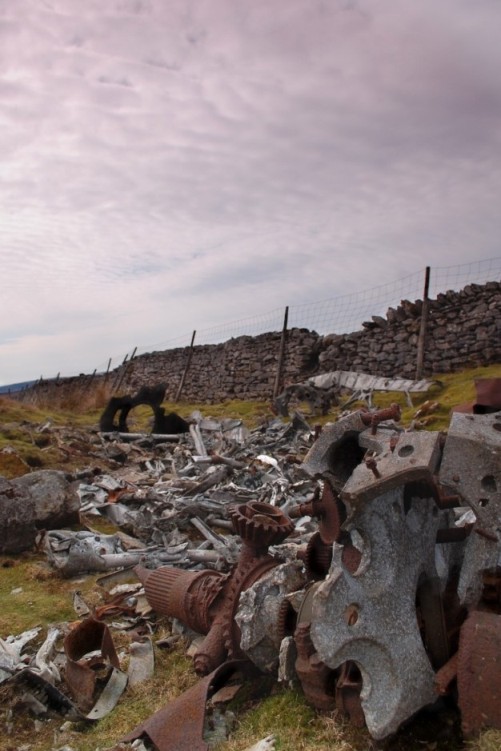Wellington bomber HE226
‹ Return to Air Crash Sites

Wellington bomber HE226
Wellington HE226 of No17 OTU (Operational Training Unit) was on a cross country training flight when it crashed with the loss of all crewmen on May 28th 1945, near the village of Conistone in the Yorkshire Dales.
It appears they had missed the designated turn point and nearly 40 miles from where they should have been, descended through cloud to get a visual fix only to meet the high ground of Bycliffe Moor rushing up towards them.
The crew were all members of the Royal Air Force Volunteer Reserve and the Royal Auxiliary Air Force. These were no weekend flyers however. Volunteers accounted for the first Luftwaffe aircraft shot down over Britain, were the first to knock out a V1 flying bomb, and fought in the Battle of Britain.
Crew;
Pilot; W/O Edward C Cole RAFVR
Navigator; Sgt James Mann RAFVR
Bomb Aimer; F/Sgt Arthur J Griffiths RAuxF
Wireless Op; Sgt John Duncan RAFVR
Air Gunner; Sgt Herbert H Rawnsley RAuxF
There is a lot of wreckage at this site, much of it deposited in sink holes, which are a geological feature of the area; limestone is dissolved by rain water over time, and the ground collapses in numerous depressions, indicating systems of caverns below.

EDIT 30 MARCH 2021.
These 5 photos were all taken by Stephen M and are used with his kind permission. They are much better photos than the gloomy lead photo above and show the debris off better too.





On this day, another OTU Wellington bomber also came to grief with the loss of all on board while on a cross country training flight, Canadian crewed Wellington HE871 which fell out of a storm cloud and into the sea between Wales and Ireland.
9 comments on “Wellington bomber HE226”
Leave a Reply Cancel reply
Image Information
-
Full Size: 501×751px
Aperture: f/6.3
Focal Length: 18mm
ISO: 200
Shutter: 1/125 sec
Camera: NIKON D40



Nice angle on the main shot Ian – I wondered if anyone has explored the caves to see the rest of the wreckage
Jeez, thats the most wreackage from any aircraft site that I have seen. Sink holes eh!……..learn something new every day!
nice to see its still there and nobody nicked it great story ian
Great background Ian , and yes there is an awful lot of this aircraft left on site but in very very small pieces .
The more you look for parts the more you find at this site . Unfortunately it is very hard to photograph and show the wreckage within its enviroment due to its location in the sink holes and the proximity of the wall blocking the view .
Good effort Ian .I particuarily like the shot with the arrows marking the sink holes .
Have you got the grid reference for the Wellington bomber HE226 crash site on bycliffe Moor, I’m researching the 17otu
Hi Sarah,
Grid ref is provided on this website, Sean visited the site just last month.
Ian
UK Air Crash Site Coordinates
Is permission required to visit this site?
If so, from whom?
Cheers.
Hi Mick, the crash site is in an open access area so no permission is needed.
Ian